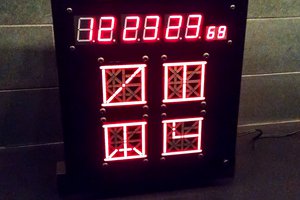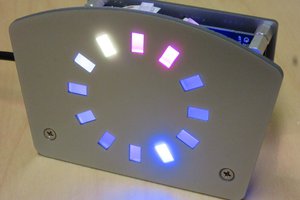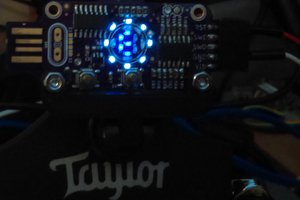My first take on the LED nixie was to solder 7 segments together in free space using heavy gauge wires for the supports on the bottom segments and the finest wire I could find (10um diameter!) for the others thinking this would look most like a Nixie tube. It looked good but the 10um wire was very difficult to work with and it took forever to hand solder the segments. I didn’t think I could make any two that looked alike even after making a simple jig to hold the segments in place.
I tried putting the hand made digit into a small glass jar as the first try at making the tube part of the Nixie tube. It worked but the shape of the jar wasn’t very good, not so tube like. Then I had the idea to use a laboratory test tube with a rounded end. You can get test tubes made from plastic on Amazon for cheap - the product description says that the tubes are 2 liter soda bottles before they have been expanded. Perfect!
Then I decided that it would be ok to use a black pcb to hold the segments, this way every digit would come out the same and it would be much easier to assemble so I made a pcb sized to fit inside the test tube. I used OSHPark to fab the boards using their After Dark service for the black substrate.
By the way, the 20mm filaments have an active (light emitting) length of only 11mm. I made the pcb with solder pads 14mm apart and a slot for the LED 11.5mm long by 2.0mm wide. This size works really well although you do have to trim some of the extra metal off of the ends of the filament and trim the silicone just a bit with an Exacto knife.
The clock is my way of showing off the LED Nixie tubes with something interesting. What else would I have made? A frequency counter perhaps but the clock seemed more useful. I choose Adafruit’s HUZZAH32 Feather board with the ESP32 because it had WiFi and I could program it in circuit python which sounded like something which would be good to learn. When I got into it, I ended up porting the Arduino Uno single digit code to the ESP32 and the 6 74LV595 shift registers and had a working Arduino project before I could even start with the circuit python. So, Arduino it is, circuit python for some other day!
The main board has a mode switch and 4 pushbuttons but the software doesn't do anything with them yet. My idea was to use the switch to set 12/24 hour time and the buttons to set the time of day but the NTP time service works so well that I never got around to a way to enter the time manually. Maybe someone else would like to take on that task?!
There are a few other YT videos related to this project you can find on my channel.
An early video of the 7 segment digit and test tubes: https://youtu.be/PHvTuugFZ2U
First firmware before I had pcbs, using Saleae logic analyzer to test SPI: https://youtu.be/feG9bJFWwdc
Prototype digit with glass jar: https://youtu.be/DN6Z8kjTz60
38mm white LED filament digit: https://youtu.be/wt5i9RpoqX8
 Jay Hamlin
Jay Hamlin


 RIUM+ (Mike Ando)
RIUM+ (Mike Ando)
 Tom Dowad
Tom Dowad
 rrace001
rrace001
 Jan
Jan
Very nice. 👍 I'd like to have a go at making huge digits someday with longer filaments and your experiences are useful. The "test tube" idea is inspired. It's a pity not the whole length is light emitting.